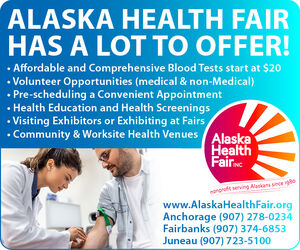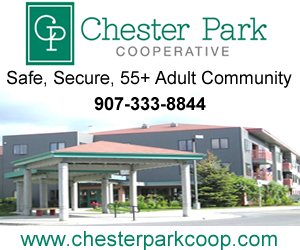Alaska needs its seniors included, involved
The growth trend in the aging population suggests that increasing numbers of Alaskans are rapidly becoming seniors at a pace that may exceed service capacity. Across Alaska and the nation, life expectancy has also increased substantially for people experiencing intellectual and developmental disabilities.
As Alaskans with disabilities are living longer, service provider agencies across the state are looking for ways to support seniors of all abilities. Although it has been stated that older adults present unique public health challenges and may become vulnerable to malnutrition or placement in care facilities, Alaska’s senior population also provides rich information on the opportunities for healthy aging through strong social relationships, community involvement, and a sense of purpose.
By keeping seniors integrated into the fabric of society as they age, all Alaskans are well suited to make sure that our older adults age healthfully and to delay the need for assisted living.
What seniors said
To discover the healthy aging needs of seniors in Anchorage, we have conducted two separate qualitative studies (one in 2014 and one in 2015) to find out more about how Alaskan seniors view their opportunities for a good quality of life. The research questions explored four topic areas of healthy aging: (1) nutrition, exercise, and general health; (2) meaningful social relationships; (3) community inclusion and involvement; and (4) the need to feel a sense of purpose.
Twenty-one seniors were interviewed, 9 men and 12 women, aged 60 to 87 years old. Participants included white, black, Asian and Alaska Native elders, and interviews lasted between 28 and 101 minutes. Nine significant themes that emerged from these discussions include: community involvement and inclusion; personal values and freedoms; sense of purpose and sharing talents; social relationships; cultural identity and the importance of local foods; spirituality and faith; financial resources; physical limitations; and death/dying/disease.
People with strong social networks tend to be healthier. They get more physical activity and have a healthier diet, through the support, encouragement and companionship with friends and family. This was especially true for our Anchorage participants, where older adults with strong social supports reported that they eat with and engage in activities with their friends during the day, resulting in a generally positive influence on each other.
‘Edna,’ an active 72-year-old woman, said “it is a social thing. I’m not one to just exercise at home alone. I’ve done it, but it’s not something that you can do on a regular basis. It’s not fun. I want to enjoy it. I think exercise is fun, it feels good.”
‘Gilbert,’ a 72-year-old, retired schoolteacher said that he would be more active, “if I had a physical activity partner. They guy that lives down the street has a good bicycle. I mean, I would bike with him...”
Gilbert is a friendly and social man, seeking out nearly anyone he can find to show pictures of his grandkids; however, he has had limited success interacting with neighbors and the Anchorage community.
Family ties are also important to the healthy aging of Alaskans. ‘Kyung,’ a 67-year-old married, retired man from Korea, reports that the social relationship with his wife regarding food is more important than its nutritional value, “Because I’m not looking for food; I’m looking for my relationships. So I’m thinking about more relationship than food. So [some] food I do by myself, you know, standing [in the] kitchen by myself or eating my own thing…but most time with my wife. My wife cook[s] very well.”
‘Nolee’ has strong family supports all over the state of Alaska. She has many relatives that live in Anchorage and nearby towns, where she eats with family at least once per week. Because she was raised on a traditional subsistence lifestyle, she also relies on her family members who live in rural Alaska to provision her with “fish, caribou, moose, ptarmigan, you know, a lot of berries: salmonberries, blueberries, raspberries” from her family members who live in outlying areas. Her family in Nome, Dillingham and McGrath get her seal oil and watermelon berries in exchange for fresh fruit from the markets in Anchorage that they cannot obtain in rural Alaska.
“It’s a bartering system,” she reports. She says these food items are meaningful for her when they get together as a family. She stated, “we always have smoked fish, we always have fish pie, you know that’s part of the way we grew up.”
Nolee says that these foods are not just a supplement to her diet, but these Alaskan foods are culturally meaningful to her, another common thread among Anchorage participants. Friends and family are able to positively influence healthy aging patterns through support, encouragement, and companionship, especially in diverse populations of seniors.
The results of these two studies reveal that there are ample opportunities for the community to engage with seniors to ensure their healthy aging, since friends, family, cultural identity, social support and community inclusion are important factors for older adults in Alaska.
Taking care of each other and ourselves
By utilizing community resources to ensure inclusion for all Alaskans, we are able to reduce some of the caregiver burden. Extended family members, primarily women, often provide the majority of supports for older adults, while trying to balance the many demands of their career and nuclear family. The average caregiver is female, 55 years old, and provides support with transportation to appointments, chores, medication administration, medical tasks, shopping, managing finances, among other errands, often modifying her own work schedule to meet these demands. Ensuring healthy aging and community inclusion of seniors helps to reduce the workload of the caregiving segment of our population.
In addition, taking care of our seniors now makes good fiscal sense. The financial climate Alaskans now face includes dramatically changing economic concerns with the tremendous fall of oil revenues, the potential loss of the PFD, and tighter budgetary constraints. These economic shifts will encompass many areas of the broader community, but our most vulnerable populations such as seniors and the disabled, will likely feel the greatest impacts of budget cuts. Including seniors in social activities, church communities, local events, and making sure we all feel a daily sense of purpose can delay or reduce the need to rely on expensive senior services.
Intergenerational payoff
Seniors are not the only ones who benefit from such community inclusion. By integrating intergenerational segments of the population, other research has also found that children and adolescents benefit from having positive elder role models. Such intergenerational relationships increase children’s sense of self, purpose, security, and joy as much as it does for their elderly counterparts.
Social interactions between the young and older adults has also been shown to result in greater emotional and social intelligence, increased skills and knowledge, and even strengthened immune systems and reduced stress for both older and younger individuals.
Public health initiatives to address healthy aging usually include health education, weight management and nutrition, promotion of health behaviors, and increased health screenings. However, we can all play a part in boosting the health and quality of life of our seniors. Inviting older adults to share meals, engage in physical activities, and spend time with community members not only increases happiness and a sense of purpose for seniors, but such community inclusion efforts can improve the quality of life for all Alaskans.
Britteny M. Howell, MA, ABD is the coordinator of research and development for Hope Community Resources. She sits on the Anchorage ADA Advisory Commission, the Alaska Humanities Forum, and the Alaska Aging and Disability Coalition. She is currently finishing her PhD in anthropology and gerontology at the University of Kentucky. Margaret Grasse is a Registered Nurse and works at Hope as a community health nurse. She recently completed the Leadership Certificate in Business Management program from Wayland Baptist University.












